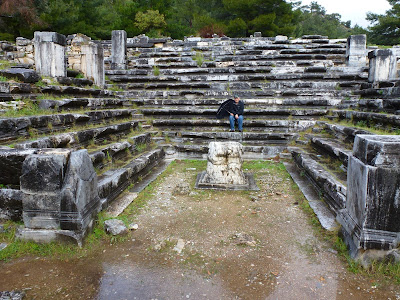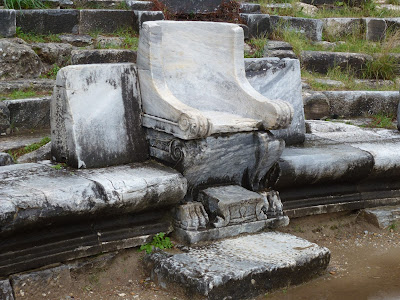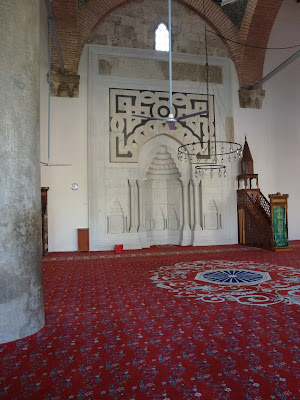Our bus ride from Cappadocia was actually 14 hours long. We finally arrived in Kusadasi, and we were fortunate, indeed. Our hotel room had a view of the
Aegean Sea. There is a walkway along the seashore, so there is a lot of activity when we look out of the window--walking, fishing, playing, talking.
One advantage of visiting now is the lack of crowds but the weather is cooler
Priene: This is an excavated Greek city
ruins. The Aegean Sea used to lap the shores of this city.As time went on, the silt
from the Meander River (This is where the word meandering comes from.) which
flowed into the sea near this city eventually built up the land forcing the sea
to recede. These city ruins now overlook
fertile farmland. This city was set up
so that all secondary roads ran at right angles to the main road. It also has a large amphitheater which seated
about 6,500 people with the first row reserved for the VIPs, and a large bouleuterion (an outside city council chambers).
Senator David in the bouleuterion: "How can we solve the drainage problem we seem to have here?"
The sea is about 10 km away now.
Amphitheater
Seats for VIPS
Residences
Spring is coming
Miletus: This Greek city archaeological site has
not been excavated. In its heyday, it was a port
city, but is now part of the fertile plateau. When St. Paul was evicted from Ephesus, he came to Miletus to preach about Christianity to the inhabitants. Our guide showed us the ruins of a very large Roman bath, the Baths of Faustina, situated here. These were heated by in floor heating--water heated by fuel and distributed by pipes under the floor of the pool.
Amphitheater
Certain groups of people, i.e. the Christians, would mark a section of seats with either writing or by symbols.
Covered walkways such as we have now in our stadiums
The sea used to be just beyond the trees, and there was a small bay where the small white pillars are situated.
Bouleuterion (council chambers) and the agora (shopping centre)
Baths of Faustina,
Fountain on the edge of the bath
Pillar bases were all different
Fine workmanship
Initial of the contractor
Secret signs of Christianity
"Oh wise and mighty David, what does the future hold?"
Pillar toppled during an earthquake
We visited a mosque in order to get a closer view of St John's Basilica where St John is buried. The basilica is not open to the public.
Mosque Garden
St. John is buried under St. John's Basilica
In the foreground of the picture is a column of the Temple of Artemis which was one of the Seven Wonders of the Ancient World. In the background at the top of the hill on the left side is a medieval castle. Below the castle is the mosque. On the right side of the picture behind the column is St. John's Basilica. Three religions have existed on this site at different periods of time.
St Mary’s Church: During the persecution of Christians, St. John brought Mary, Mother of Jesus, to Ephesus. St. John stayed in Ephesus. Mary lived up in the hills in a little house. The Christians in this area would make a pilgrimage to her house even after it had disappeared. In the 1800`s, a German nun had visions and described where Mary`s house was. This nun had never been to the area. Priests from Izmir (a city north of Ephesus) followed the nun's visions and the information from Christians in the area who made pilgrimages to the spot; and found the base of an old house up on Bulbul Dagi not far from Ephesus. A small chapel was built on the footprint of the house. This chapel has continued as a pilgrimage place for the Christians. Three Popes have visited this site and left gifts.
The base is all that is left of Mary's house
Prayer Wall
We were all looking forward to our next stop.



















































No comments:
Post a Comment